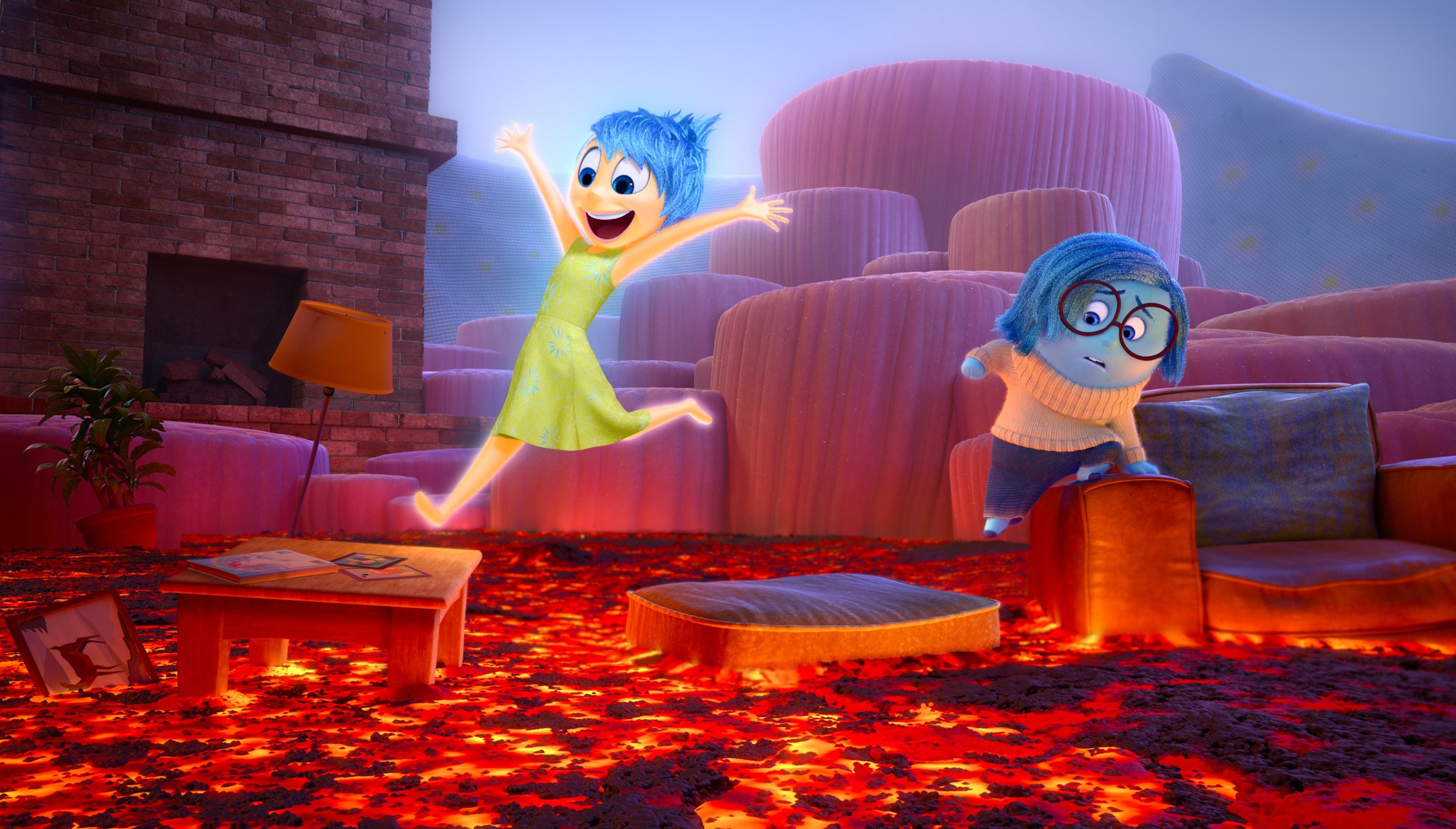
The most profound—as well as profoundly good—Pixar movies are the ones that seem the least plausible as story pitches. Consider Up (crushed by encroaching development, old man flies away with his house) and WALL-E (environmental wasteland, nice robot). Now, there’s Inside Out, which defies the conventions of family movies by being an animated comedy about brain chemistry and situational depression.
That makes it perhaps the craziest movie Pixar has ever come up with. Imagine Fellini using animation to create a narrative starring the limbic system, with diversions to the subconscious (“where they take all the troublemakers”), treacherous trips into abstract thinking and rides on the highly erratically scheduled train of thought. From a story hatched by co-directors Peter Docter (Up, Monsters, Inc.) and Ronaldo del Carmen, Inside Out is nearly hallucinogenic, entirely beautiful and easily the animation studio’s best release since 2010’s Toy Story 3. Stylistically Inside Out is nothing like Richard Linklater’s Boyhood, but for its scope in examining the maturation process, it might well be called Childhood.
The central human character is an 11 year-old only child named Riley Anderson (voiced by Kaityn Dias) who loves hockey and her parents, but the story is mainly told from the perspective of five core human emotions. Joy, sadness, anger, fear and disgust are all depicted as characters that live within Riley. (Usually scientists go with happy when they’re talking about emotions, but Joy makes a better name for anyone voiced by Amy Poehler. Talk about type-casting; you wonder if the movie was built around her Parks and Recreation persona). These five characters move in and out of control of the central keyboard of Riley’s brain until a crisis is set in motion by the Anderson family’s relocation from Minnesota to San Francisco. While the movers dawdle and Dad’s “investors” jerk his startup chain, the Andersons live in an empty, narrow, dirty house. (Even the perkiest real estate agent would stretch to call this a Victorian, but in the nation’s hottest real estate market, it probably cost at least $1.5 million.)
No wonder Riley has trouble summoning her joy, especially facing a new school. Sadness (the wonderful Phyllis Smith, from The Office), blue-skinned and bound up in a tight turtleneck sweater, keeps touching and thus sullying all the old good memories; soon, Anger (Lewis Black) moves into the driver’s seat, with Fear (Bill Hader) hovering near by and Disgust (Mindy Kahling) snarking from the other side. Riley plunges into a depression and the movie becomes a race against time as her good memories crumble and misery closes in. In the Pixar vision of depression, Joy and Riley’s imaginary friend from her earliest years, Bing Bong (Richard Kind) are reduced to tiny pinpoints, bright lights in sea of coal-colored thoughts and memories. They have to literally climb over the misery to get out.
The brain itself has components that look like a giant gumball machine. Riley’s various islands of personality (friends, family, hockey) could be the kind of alien outpost where Han Solo has drinks. There is an abyss, naturally, but overall this is a place of little order and great mystery, which you might not expect from Pixar, given its propensity for explaining away say, the sources of scary dreams (Monsters, Inc.). To be lost in its bowels is terrifying even for perky Joy. One of the movie’s best gags is the snoring, red-nosed hulk hidden away in the subconscious. To see the complexity of the human brain laid out in animation, right down to arching pathways of light that look a lot like synapses, is mind-blowing in the same way Fantasia is mind-blowing.
But what makes the movie so rich and enlightening, even for an adult well acquainted with their own blue periods, is the depiction of emotions not as at war with each other but rather in a constant juggling act to keep their human going. Riley’s mother and father, voiced by Diane Lane and Kyle MacLachlan, have their own five-character emotion parade. It is true that Riley’s Disgust eggs on Anger, and that Joy, a bossy hedonist, would rather Sadness stay within the chalk circle she draws for her. But the emotions are all in this together, in support of Riley. One of Inside Out’s great triumphs is Joy’s dawning realization about the need for balance and the gifts that unmasked Sadness can bring, including the support of one’s loved ones.
Sadness is of course, particularly well suited to movie theaters, which are great places to cry. (As Joy urges Sadness to get out of her funk, she keeps reminding her of “that funny movie where the dog died”). Which brings me to a sidenote: For four years I shared a movie beat with TIME’s legendary critic Richard Corliss, who died in April. Richard could be territorial. A Pixar movie was a bone he never wanted to give up (unless, well…Cars 2). For me Inside Out was tinged with sadness that he is no longer here to see it. What would he have loved best? The sly joke that Anger is the designated newspaper reader in the group? (Choice headline: “Replaced! No Friends for Riley!”) Or the way Riley’s memory service team clears out all her piano lessons except for “Chopsticks” and “Heart and Soul?” Or perhaps the wistful lyrical pas de deux when Joy dances to one of Riley’s favorite memories of skating on a frozen Minnesota lake? Yes, to all of them, the sorrow and the joy.
More Must-Reads from TIME
- How Donald Trump Won
- The Best Inventions of 2024
- Why Sleep Is the Key to Living Longer
- Robert Zemeckis Just Wants to Move You
- How to Break 8 Toxic Communication Habits
- Nicola Coughlan Bet on Herself—And Won
- Why Vinegar Is So Good for You
- Meet TIME's Newest Class of Next Generation Leaders
Contact us at letters@time.com